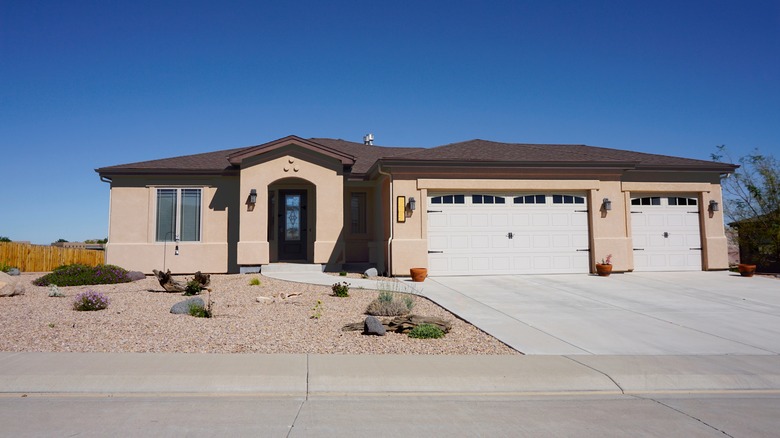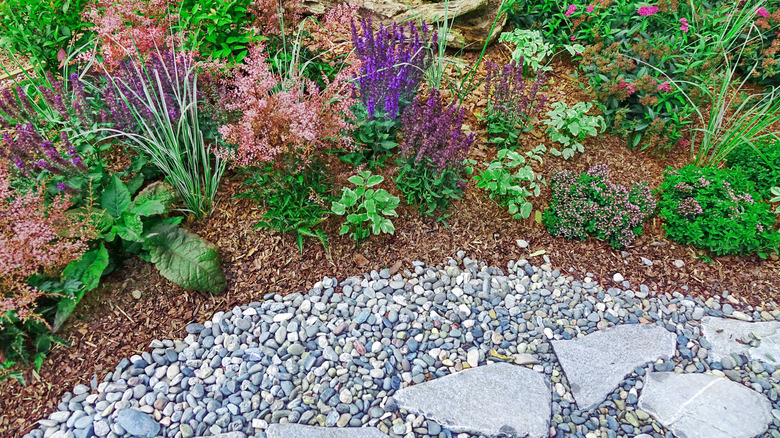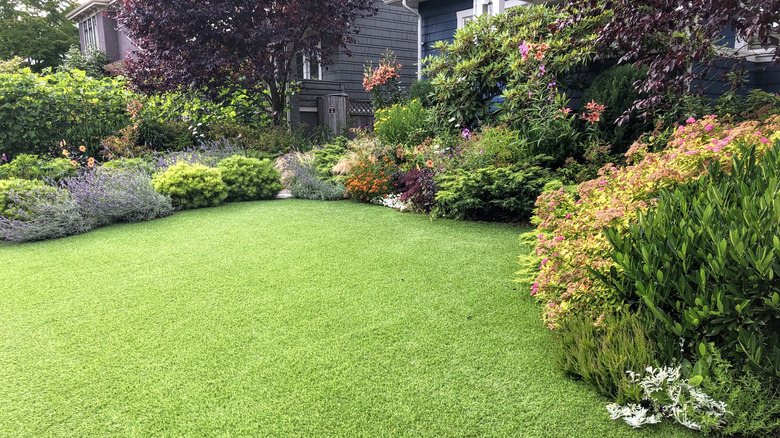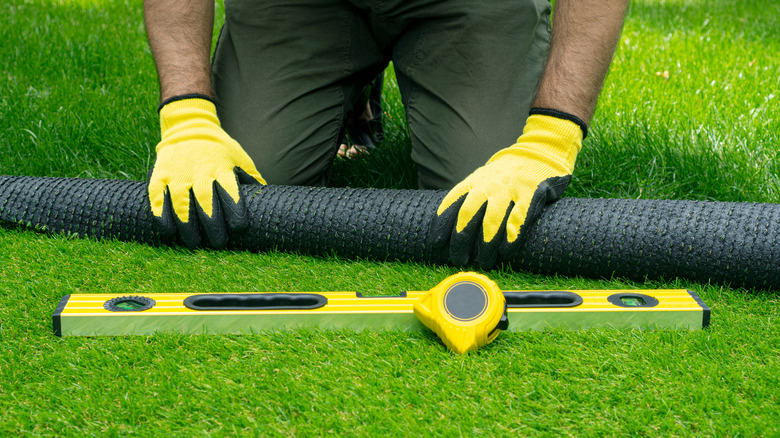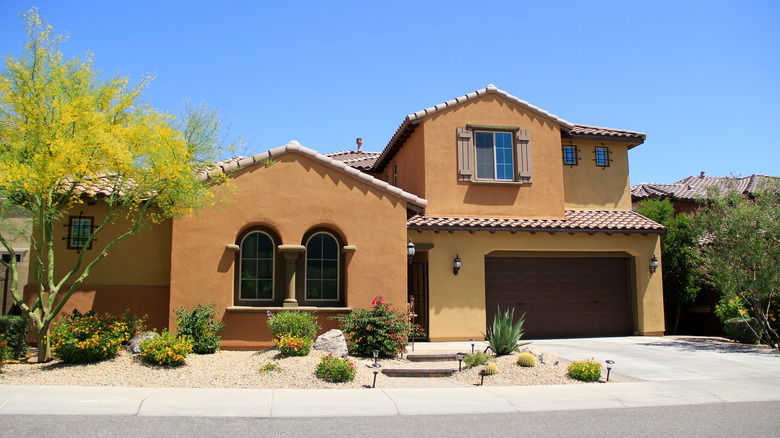What To Know About The Anti-Lawn Movement
It takes a lot of work to maintain a proper front lawn, regardless if the grass is natural or artificial, and people have started to go for other alternatives. However, this hasn't been easy, as the idea of the perfect front lawn is a staple of American homes. As noted by Garden & Health, white picket fences and green lawns have always been seen to go hand-in-hand as a representation of independence and ownership in the U.S. Things are changing, though, and the growing awareness of the environmental impact of the individual is pushing a lot of people to be more intentional with their choices.
According to Gardenista, lawn maintenance takes up a third of all home water use and is an environmental threat in dry climates. The electric tools used in maintaining lawns also pollute the air, while fertilizers pollute the groundwater. The anti-lawn movement aims to tackle problems like these by reducing the resources that go into preserving front yards and making them more in tune with nature instead. Here's what to know about the anti-lawn movement, from its background to the alternatives it offers.
History and popularity
The anti-lawn movement seems to have been around for a long time. According to Columbia Insight, there have been mentions of it in the media since 2008, and it has continued to gain momentum alongside the increased knowledge about sustainability. As the conversation about saving bees and butterflies grew, for example, so did sales of fescue and native plants for one Wisconsin plant company, via Scienceline.
The pandemic might have also contributed to the growth of this movement. Gardening became a new hobby for many people during that time, especially with new water use restrictions in certain states, says Garden & Health. Even though the anti-lawn movement is certainly more known now, it isn't leading to lawns being torn out immediately, says Columbia Insight. Its popularity lies in spreading ideas about minor changes that can make a difference and how to make gradual transitions away from typical lawns.
How to get involved
"No Mow May" started in the U.K. in 2019 but has now spread to over 30 municipalities in the U.S. This campaign involves letting your front lawn grow for a month to support pollinators that come in the spring, via Popular Science. It is a great way to start because you can make an impact without doing anything and also get a break from mowing! Other simple ways to get involved include reducing your lawn area, watering it less, steering clear of chemical pesticides and fertilizers, and cutting out artificial lighting, per Healthy Yards.
If you decide to completely transform your front yard into a garden, learning about your climate and what plants will flourish in it is essential. Consider if you're in a drought and how much rain to expect because that will let you know how much watering you'll need. Other factors to consider are wind levels, soil type, and hardiness zones. When you're familiar with your environment, you can choose the fruits and vegetables your household would enjoy.
The U.S. movement
Some states have taken measures to conserve water and other resources to combat drought, heat, and other extreme effects of climate change. California has prohibited the watering of non-functional turf in commercial and industrial areas, referring to lawns that only serve visual purposes. According to the Office of Governor Gavin Newsom, the state has also embarked on a goal to convert a significant amount of ornamental turf by 2030. Nevada will outlaw around 40% of the non-functional turf in Las Vegas starting in 2027. However, these efforts are not new, as Las Vegas used to have a program encouraging homeowners to take up more sustainable landscaping in 1999, via Green Industry Pros.
While the anti-lawn movement is undoubtedly growing on the individual and state levels, there is still some resistance throughout the country. One central part of this opposition is how most homeowners keep their lawns heavily influenced by their neighbors, as seen in a study quoted in Scienceline. When people overcome this and take the initiative, however, their non-traditional front lawns tend to start up conversations.
Pros and cons
The concept of the perfect lawn has changed what people think about nature and aesthetics. While lawn grass has the semblance of nature, it takes a lot of effort to achieve its flawless appearance. This doesn't represent the relaxed spirit of nature which goes through changes to adapt to its environment. The perfect lawn also leaves out another core part: nature gives back. By providing things like nourishment, air, and medicines to both humans and animals, nature is significant to the well-being of living things. Lawn culture, however, has little value outside of its visual appeal.
On the other hand, lawns appeal to those who use the yard a lot. If you need an outdoor space for your children and pets to play, a garden or bed of gravel won't meet those needs. Lawns are also better if you don't know how to manage a living garden — or simply don't want to. An artificial grass lawn provides the perfect look without any work; synthetic grass can last for over 25 years and requires no maintenance, all while giving off the appearance of natural grass, per Gardenista. The anti-lawn movement is a good idea in terms of addressing the damage caused by typical lawn culture. However, it's good also to note that lawns may be the better option for some households and can be kept in a way that won't be as costly to the environment and health.
Alternatives to a natural lawn
Instead of maintaining a beautiful turf that can only be looked at, people are choosing to use that space to grow vegetables and fruits they can enjoy. They are embracing nature by bringing in seeds that are native to the area and letting the front yard look alive and exciting. This is why some of the most popular alternatives to a lawn are plants and shrubs, which usually need less water, chemicals, and maintenance than the typical turf. Succulent gardens, gravel, and mulch are some other alternatives, per Garden & Health.
If you really like the appearance of grass, Gilmour recommends groundcovers like Japanese sweet flag grass, cotoneaster shrubs, and Creeping Jenny. These grass alternatives won't grow tall, and you won't need to cut them down. In addition to lawn alternatives, there are options for the type of landscaping equipment homeowners use and how. Switching from gas to electric machines and mulch-mowing, as opposed to leaf-blowing, are some ways to reduce air pollution, via Healthy Yards.
